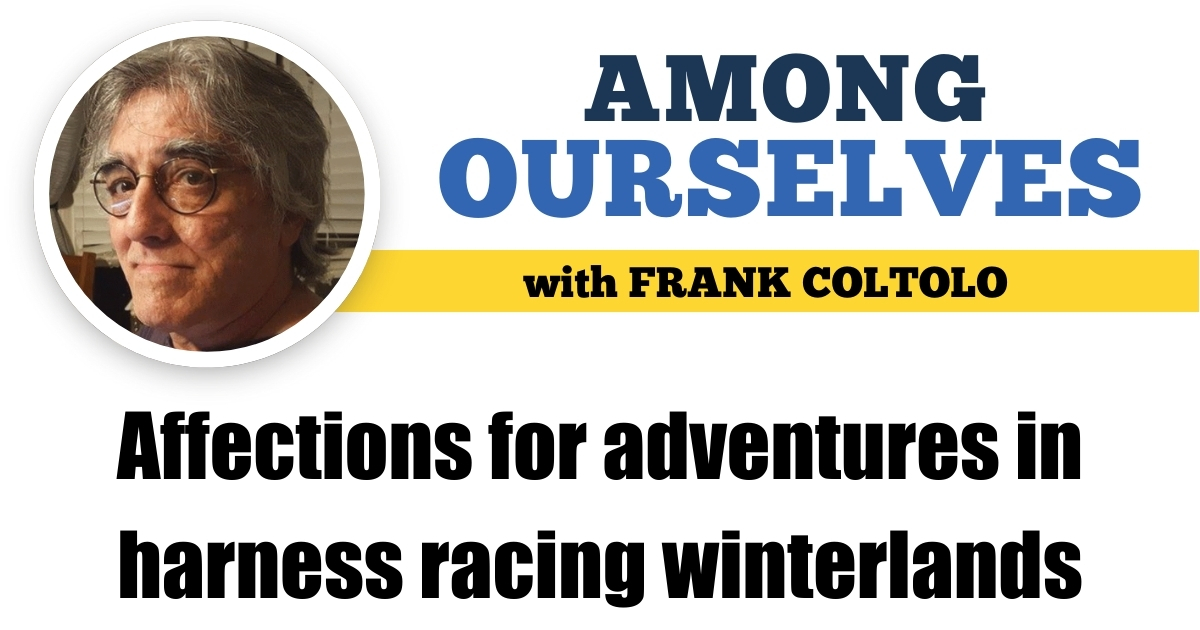Affections for adventures in harness racing winterlands
by Frank Cotolo
A kaleidoscope of reasons only a panel of Freuds would dare attempt to analyze might approach an explanation as to why I developed a penchant for French Canadian harness racing. A kid raised in the concrete jungle of Brooklyn, NY, in the 1950s and ’60s, was not a likely candidate for such a fondness. Yet, here I am smitten with nostalgia for it.
I have some theories; but first I bring to your attention how it embraced my attention.
Evenings for horseplayers belonged to harness racing after a swarm of Off-Track Betting shops opened in all five boroughs of New York City. Race programs from Yonkers or Roosevelt meets sold at newsstands like pizza slices. And there was more to read; also popular for past performances and expert picks was Sports Eye. I read both but more often I bought the official programs.
This was before I ever visited any racetrack. I was in high school and then college while working for a rock band; I had a girlfriend across town and lived with my parents. I spent countless hours in subway cars reading Henry Miller and Thomas Hardy and Mario Puzo and Blackhawk comic books. And in those harness programs I became especially attracted to harness driver names unfamiliar to a Brooklyn tongue from a neighborhood of Italian and Jewish surnames.
Like Herve Filion. A harness driver with a surname that sounded like a French swordsman. And there were other Filions; Henri and Yves, first names never heard in choose-up softball games at Gravesend Park. The programs were robust with such given names. Lucien (Fontaine). Norman (Dauplaise). Real (Cormier)? Really?
“They’re Canadians,” an OTB friend told me. “From the French side of the country. Kwahbeck [sic].”
Brooklyn winters during the 1960s and ’70s expressed just one strong French-Canadian sports activity: Hockey. Teenaged male fans adapted the sport in an urban landscape. Instead of playing on an ice rink they played on city streets. They wore all the gear and watched the pro-hockey league’s season. They admired hockey stars with names like Jacques Laperriere, Jean Beliveau, Bobby Rousseau and Bernie Geoffrion in magazines dedicated to the league.
I got into the mix with skates and gloves and knee guards and a protective cup. I needed the cup more than any other accessory because kids learned to lift pucks at speeds easily able to cripple. Street hockey was also popular because it allowed for violence. There is an old joke: “A few guys got into a fight so bad that it broke into a hockey game.”
Winter was always associated with hockey’s home country north of America. Many U.S. action shows took place in wintry Canada. In the late ’50s and early ’60s the War Babies generation grew up watching the hit series “Sargeant Preston Of The Yukon.” It created tropes: Canadian Mounties driving husky-pulled sleds. It was filmed in America but took place in the cold and cruel Canadian landscape.
Other than TV shows and hockey I was reading literature by Canadian poet Robert Service; known as the Bard of the Yukon. I learned about him after seeing cartoon parodies of his roughshod Sam Magee poems.
Speaking of cartoons, I am a sucker for comedies set in winter conditions. The Hope-Crosby “Road To Utopia” played upon my tawdry drives for escapades in the frost-biting atmosphere of The Yukon. The variety of such material added to an already bloated version of masculinity owned by the era and embedded in melting-pot Brooklyn.
Brooklyn in summer — during school hiatus — was literally a melting pot. It boiled indoors and out. Movie theaters hanged signs that read: “COME IN – IT’S COOL INSIDE” and people paid the admission with no regard to what movies were playing. Lower-middle class neighborhood residents growled in oppressive heat. But winter? It made us feel alive. Robert Service said it best: It’s the fingers that freeze / In the boreal breeze / It’s the cold, cold, cold.
Screw summer! Bring on the bruising street hockey games and the tooth-cracking ice battles from Yvan Cournoyer and his Montreal Canadiens at Madison Square Garden. See your breath make shapes of your words as you scream for Lucian Fontaine’s pacer going three-wide to beat Herve Filion’s charge around the last steep turn at Roosevelt Raceway in bitter cold and sometimes while sheets of snow piled upon the limestone. Norman Dauplaise and Rejean Daignault and Jacques Dupuis and John Chapman also drove nightly.
Decades later I was in Los Angeles, where the winter temperatures paled by comparison to the northeast and northwest on either side of the border. But there were many chilly evenings at Hollywood Park (HP) where Canadian harness drivers thundered around the two-turn mile; some French Canadian and others from the brittle northwest. I saw John Campbell race first at HP before he went east. And I met my all-time favourite [sic] – Shelly Goudreau.
















